Emha Ainun Nadjib and Kiai Kanjeng at Espoo City Theatre
Indonesia's gamelan fusion orchestra, Kiai Kanjeng, on stage at various venues in Finland, are like no other musical group. The dynamic is the same - i.e., a performance - those watching and those being watched, but with a KiaiKanjeng performance there is something more for both parties. The themes raised by Kiai Kanjeng during their performance allow the audience to be more than mere passive observers; they are encouraged to think, discuss and participate.
Quite often, members of the audience will spontaneously come up on to the stage. They abandon their roles as audience and take on a role as people engaged in a cultural interaction - humanism - spontaneous singing, a part of a people or a nation, makers of culture, economic actors, political commentators and other roles - freely and openly. Kiai Kanjeng always request the lights on full at venues where they play.
"You are not our audience and we are not your performers. We are brothers in humanity. Among the ties that bind us are all the key themes in global relations" the family, arts and culture, suffering, politics and much more. Our music has always been arranged to reflect that."
These words are almost always said by one person or another at every performance of Kiai Kanjeng. Just as in their performances in tens of cities in England, Germany, Scotland, and Italy, their presence in Finland was astounding in almost every way, touching upon every dimension of human experience. This they achieved without relinquishing any of their artistic responsibility towards the musical arrangements that they used.
Heikki Sarmanto, one of Finland’s elite pianists, said: “Their music opens a thousand windows. Their sounds truly force us to fly across various horizons. I bought five of their cds and I’m listening to them every day one after the other. I can’t help myself. I am going to bring Kiai Kanjeng’s music to the studio and I am going to incorporate my piano into it. Then, I’m going to send the results to Indonesia and I’m sure we’ll work together in the future.”
At the last concert of their Finnish tour at the main Espoo Theatre, Heikki Sarmanto came up on the stage with tens of other members of the audience dan danced enthusiastically to the last number - ”Rampak Osing”. One French drummer who had made a creative exploration of music from Cuba and Senegal, choosing them for their original musical forms, met with Kiai Kanjeng after the show. “You’re all crazy,” he said. “I saw you bringing in all those old instruments. I have studied all forms of music and I thought I could imagine what your music would sound like but I would never have imagined that your arrangements would sound like that. I could not have predicted even one of the musical momentums from among the arrangements you played. You’re all crazy!”
Kiai Kanjeng’s music takes in and makes reference to all musical forms from across the globe. They also really like to tease the audience with a song that sounds as if it emanates from Java, or from some other age, only then to fade in to a jazz number. Or, a shalawat (song in praise of the prophet Muhammad) which segues into the blues, without any change in notation or rhythm, even switching from Arabic to English mid-song.
Then they’ll introduce an ethnic Sulawesi Bugis number, going into “You Raise Me Up” for a few bars before crossing over to Sunda with a version of “Imagine”, continuing on to Madura and closing on “Blowing in the Wind”. Perhaps’ they’ll begin with a country song, swing into a classic Ummi Kultsum song in Arabic, then fall back into Indonesia’s popular ‘keroncong’. A number of their explorations truly evoke all parts of the world, both shaken and stirred in a dynamic arrangement and maximum warmth.
One member of the audience felt particularly enthused by this combination. But what made the greatest impression on the audience were the Javanese songs and those from the Middle East. These had the greatest attraction because they could have come from just anywhere. Some of the audience commented that songs originating from the west were nowhere near as interesting.
”Perhaps it’s because those songs belong in genres like ‘pop’, while other songs are deeper and more sensitive.” Certainly it was the first time a Finnish audience had been treated to an Indonesian group who could compile such a musical mosaic with such genius, taking in all nuances of music.
One of the audience suggested the performance be titled “Kiai Kanjeng: Bringing Warmth to a Cold Finland”. Everyone knows the Finnish character, they are known as introverts, shy, to the extent that they do not even applause easily. But with Kiai Kanjeng they would spontaneously break into applause, cry out, stand and shout “we want more…we want more…”, even after the third standing ovation.
And in the last performance at the Espoo theatre, they came up on stage and danced. This is perhaps the challenge of Kiai Kanjeng; how to, with sensitivity, encourage a sense of enthusiasm among the Finnish people, or indeed among other peoples, with all their different characteristics compared to the people of Java, and their different forms of expression.
The worshippers in the Munkkiniemi Church, Helsinki, just as the Muslim worshippers in their mosque earlier, had hesitated to applaud during a performance in the church. They also looked right and left for assurance before they would commit themselves to clapping. But as soon as one
applauded, all would join in and it became ‘acceptable’.
That was a beautiful evening. Kiai Kanjeng brought their Islamic shalawat songs to the church, surrounded by statues of Christ on the Cross. The Protestant congregation actually requested Islamic songs. 90% of Finns are Protestant, but many people are secular in their daily lives and religion has a different meaning for them. Perhaps because of that, and experiencing the enthusiasm and spirituality of Kiai Kanjeng’s music, the Finns present also felt the importance of spirituality that night.
Are Muslims allowed to bring shalawat into a church? Emha answered: “The Prophet Muhammad (may blessings be upon him) said that wherever we > worship, that is a mosque. So wherever we express our love for the Prophet, that is a fitting place for shalawat.. If Muslims may not perform shalawat for Christians, then much less may they perform for devils and demons. That’s why we need a technology that will prevent devils and demons from hearing our voices. Because they can hear the silent voices of our hearts and they can hear the voices of our spirits even when we do not speak, so what is the solution?”
Kiai Kanjeng performed a number of song arrangements that many might consider to be church music. But if you listened to the lyrics you would hear the words of spiritual Islam in the form of shalawat verse. Emha said: “The music is just the fork and spoon. In every restaurant the forks and spoons are used by people of every religion, regardless, and in some small street stalls in Indonesia they’re probably used by ghosts too. It doesn’t mean that Muslims have to recite the Christian creed, anymore than it means that Christians should recite the Muslim profession of faith or sing the Shalawat Badar (a well-known and popular shalawat commemorating a successful early Muslim battle victory)”
Kiai Kanjeng also conducted a number of workshops with kindergarten and infant school children. They adapted a number of their songs and arrangements for the Finnish children, encouraged them to sing, brought them onto the stage and gave them a taste of playing their traditional Indonesian instruments.
On one occasion Kiai Kanjeng made a performance with Muslim children in the Islamic community of Helsinki. This was an important occasion for the community as many were of immigrant origin and many of their parents were of Somali, the Middle East or other extraction. For them it was important to experience and witness the plurality that is possible in life.
Following the concert in Caisa, the cultural heart of Helsinki, a performance in the Munkkiniemi Church, in WeeGee, the centre of modern culture of Espoo, and after the performance of the song that closed the dialogue on religion and culture at the Cultural Forum, we watched Kiai Kanjeng at the Espoo theatre.
For the Finns in the audience it was something entirely different from what they were used to. In the music there were messages of love, of poverty, of environmental destruction, of injustice and other themes which emerged form the music, so professionally conveyed. But there was also a great deal of spontaneity and improvisation and the building of a great sense of enthusiasm which, for the people of Finland, was like a dream in music amid the cold and gloom of the Finnish December.
ANU LOUNELA
Candidate PhD, Social Studies and Anthopology,
University of Helsinki, Finland.
Edited and translated by Ian L. Betts, author of “Jalan Sunyi Emha” on the life and work of Emha Ainun Nadjib (Gramedia June 2006). An abbreviated version of this text was published in the Indonesian daily Koran Sindo on Sunday December 10th 2006.
Indonesia's gamelan fusion orchestra, Kiai Kanjeng, on stage at various venues in Finland, are like no other musical group. The dynamic is the same - i.e., a performance - those watching and those being watched, but with a KiaiKanjeng performance there is something more for both parties. The themes raised by Kiai Kanjeng during their performance allow the audience to be more than mere passive observers; they are encouraged to think, discuss and participate.
Quite often, members of the audience will spontaneously come up on to the stage. They abandon their roles as audience and take on a role as people engaged in a cultural interaction - humanism - spontaneous singing, a part of a people or a nation, makers of culture, economic actors, political commentators and other roles - freely and openly. Kiai Kanjeng always request the lights on full at venues where they play.
"You are not our audience and we are not your performers. We are brothers in humanity. Among the ties that bind us are all the key themes in global relations" the family, arts and culture, suffering, politics and much more. Our music has always been arranged to reflect that."
These words are almost always said by one person or another at every performance of Kiai Kanjeng. Just as in their performances in tens of cities in England, Germany, Scotland, and Italy, their presence in Finland was astounding in almost every way, touching upon every dimension of human experience. This they achieved without relinquishing any of their artistic responsibility towards the musical arrangements that they used.
Heikki Sarmanto, one of Finland’s elite pianists, said: “Their music opens a thousand windows. Their sounds truly force us to fly across various horizons. I bought five of their cds and I’m listening to them every day one after the other. I can’t help myself. I am going to bring Kiai Kanjeng’s music to the studio and I am going to incorporate my piano into it. Then, I’m going to send the results to Indonesia and I’m sure we’ll work together in the future.”
At the last concert of their Finnish tour at the main Espoo Theatre, Heikki Sarmanto came up on the stage with tens of other members of the audience dan danced enthusiastically to the last number - ”Rampak Osing”. One French drummer who had made a creative exploration of music from Cuba and Senegal, choosing them for their original musical forms, met with Kiai Kanjeng after the show. “You’re all crazy,” he said. “I saw you bringing in all those old instruments. I have studied all forms of music and I thought I could imagine what your music would sound like but I would never have imagined that your arrangements would sound like that. I could not have predicted even one of the musical momentums from among the arrangements you played. You’re all crazy!”
Kiai Kanjeng’s music takes in and makes reference to all musical forms from across the globe. They also really like to tease the audience with a song that sounds as if it emanates from Java, or from some other age, only then to fade in to a jazz number. Or, a shalawat (song in praise of the prophet Muhammad) which segues into the blues, without any change in notation or rhythm, even switching from Arabic to English mid-song.
Then they’ll introduce an ethnic Sulawesi Bugis number, going into “You Raise Me Up” for a few bars before crossing over to Sunda with a version of “Imagine”, continuing on to Madura and closing on “Blowing in the Wind”. Perhaps’ they’ll begin with a country song, swing into a classic Ummi Kultsum song in Arabic, then fall back into Indonesia’s popular ‘keroncong’. A number of their explorations truly evoke all parts of the world, both shaken and stirred in a dynamic arrangement and maximum warmth.
One member of the audience felt particularly enthused by this combination. But what made the greatest impression on the audience were the Javanese songs and those from the Middle East. These had the greatest attraction because they could have come from just anywhere. Some of the audience commented that songs originating from the west were nowhere near as interesting.
”Perhaps it’s because those songs belong in genres like ‘pop’, while other songs are deeper and more sensitive.” Certainly it was the first time a Finnish audience had been treated to an Indonesian group who could compile such a musical mosaic with such genius, taking in all nuances of music.
One of the audience suggested the performance be titled “Kiai Kanjeng: Bringing Warmth to a Cold Finland”. Everyone knows the Finnish character, they are known as introverts, shy, to the extent that they do not even applause easily. But with Kiai Kanjeng they would spontaneously break into applause, cry out, stand and shout “we want more…we want more…”, even after the third standing ovation.
And in the last performance at the Espoo theatre, they came up on stage and danced. This is perhaps the challenge of Kiai Kanjeng; how to, with sensitivity, encourage a sense of enthusiasm among the Finnish people, or indeed among other peoples, with all their different characteristics compared to the people of Java, and their different forms of expression.
The worshippers in the Munkkiniemi Church, Helsinki, just as the Muslim worshippers in their mosque earlier, had hesitated to applaud during a performance in the church. They also looked right and left for assurance before they would commit themselves to clapping. But as soon as one
applauded, all would join in and it became ‘acceptable’.
That was a beautiful evening. Kiai Kanjeng brought their Islamic shalawat songs to the church, surrounded by statues of Christ on the Cross. The Protestant congregation actually requested Islamic songs. 90% of Finns are Protestant, but many people are secular in their daily lives and religion has a different meaning for them. Perhaps because of that, and experiencing the enthusiasm and spirituality of Kiai Kanjeng’s music, the Finns present also felt the importance of spirituality that night.
Are Muslims allowed to bring shalawat into a church? Emha answered: “The Prophet Muhammad (may blessings be upon him) said that wherever we > worship, that is a mosque. So wherever we express our love for the Prophet, that is a fitting place for shalawat.. If Muslims may not perform shalawat for Christians, then much less may they perform for devils and demons. That’s why we need a technology that will prevent devils and demons from hearing our voices. Because they can hear the silent voices of our hearts and they can hear the voices of our spirits even when we do not speak, so what is the solution?”
Kiai Kanjeng performed a number of song arrangements that many might consider to be church music. But if you listened to the lyrics you would hear the words of spiritual Islam in the form of shalawat verse. Emha said: “The music is just the fork and spoon. In every restaurant the forks and spoons are used by people of every religion, regardless, and in some small street stalls in Indonesia they’re probably used by ghosts too. It doesn’t mean that Muslims have to recite the Christian creed, anymore than it means that Christians should recite the Muslim profession of faith or sing the Shalawat Badar (a well-known and popular shalawat commemorating a successful early Muslim battle victory)”
Kiai Kanjeng also conducted a number of workshops with kindergarten and infant school children. They adapted a number of their songs and arrangements for the Finnish children, encouraged them to sing, brought them onto the stage and gave them a taste of playing their traditional Indonesian instruments.
On one occasion Kiai Kanjeng made a performance with Muslim children in the Islamic community of Helsinki. This was an important occasion for the community as many were of immigrant origin and many of their parents were of Somali, the Middle East or other extraction. For them it was important to experience and witness the plurality that is possible in life.
Following the concert in Caisa, the cultural heart of Helsinki, a performance in the Munkkiniemi Church, in WeeGee, the centre of modern culture of Espoo, and after the performance of the song that closed the dialogue on religion and culture at the Cultural Forum, we watched Kiai Kanjeng at the Espoo theatre.
For the Finns in the audience it was something entirely different from what they were used to. In the music there were messages of love, of poverty, of environmental destruction, of injustice and other themes which emerged form the music, so professionally conveyed. But there was also a great deal of spontaneity and improvisation and the building of a great sense of enthusiasm which, for the people of Finland, was like a dream in music amid the cold and gloom of the Finnish December.
ANU LOUNELA
Candidate PhD, Social Studies and Anthopology,
University of Helsinki, Finland.
Edited and translated by Ian L. Betts, author of “Jalan Sunyi Emha” on the life and work of Emha Ainun Nadjib (Gramedia June 2006). An abbreviated version of this text was published in the Indonesian daily Koran Sindo on Sunday December 10th 2006.

































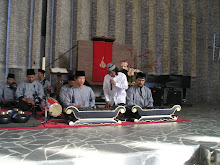
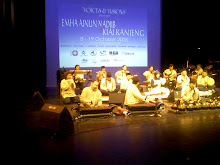

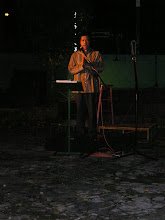



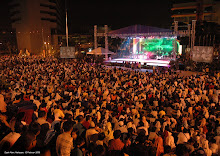
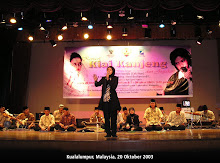
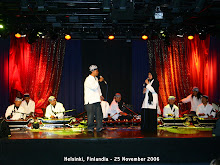.jpg)



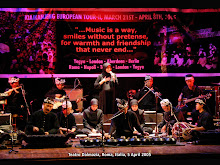


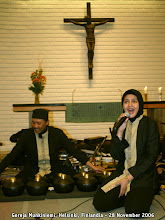.jpg)

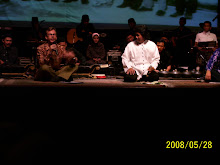.jpg)
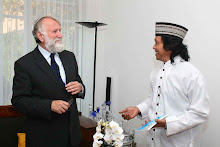
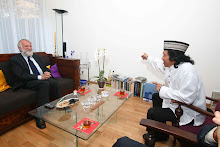
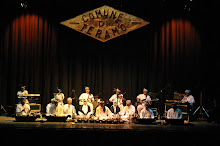


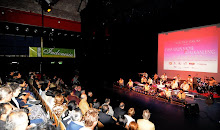

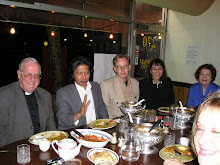


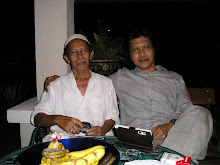
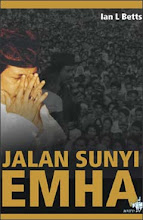
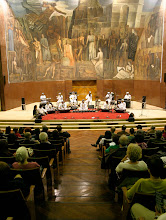
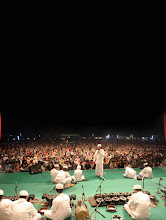

No comments:
Post a Comment